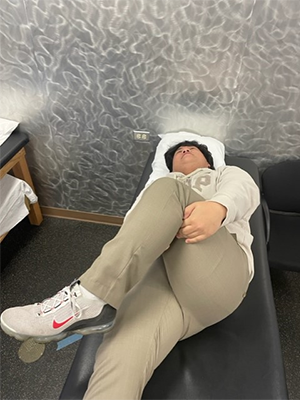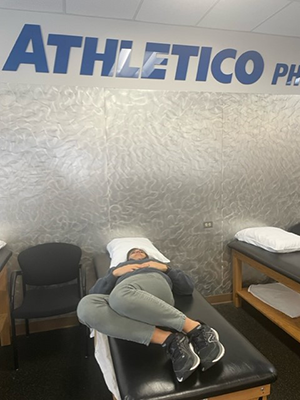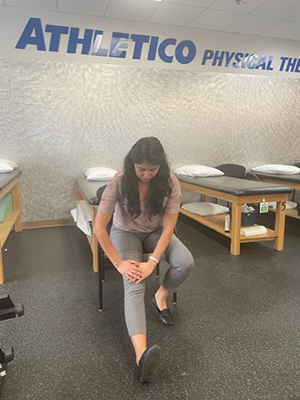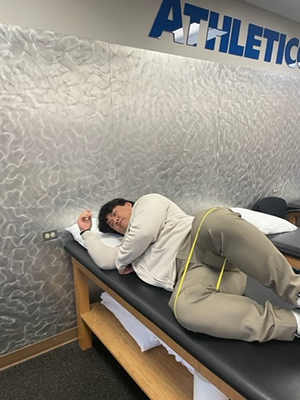When looking for areas of deficits, one of the first places I look is at the piriformis. This is a muscle located near the glutes. The sciatic nerve can run three ways: over the top of the muscle, through the muscle, or underneath. This can provide insight into where the pain may be coming from, whether from muscle tightness putting pressure on the nerve or overuse from weakness. Below are some great stretches and movements you can do to address symptoms of sciatica that hit the spot.
1. Piriformis Stretch
Begin by lying on your back with your legs straight. Bring one leg up toward your opposite shoulder, grabbing the outside of your knee with your hand until you feel a stretch in your buttocks. Keep your lower back flat against the floor, and do not allow your trunk to twist during the stretch.
2. Lower Trunk Rotations
Begin lying on your back with your feet flat on the floor and your arms straight out to your sides. Lower your knees to one side, return to the center, and repeat on the other side. Make sure to activate (contract) your core muscles and keep both shoulders in contact with the ground throughout the exercise.
3. Seated Hamstring Stretch
Begin sitting upright with one leg straight forward and your heel resting on the ground. Bend your trunk forward, hinging at your hips until you feel a stretch in the back of your leg. Hold this position. Keep your knee straight during the stretch, and do not let your back arch or slump. This should not result in any pain. If you experience pain while performing this stretch, stop immediately.
4. Clam Shells
Begin by lying on your side with your knees bent at 90 degrees, hips and shoulders stacked, and a resistance band secured around your legs. Raise your top knee away from the bottom one, then slowly return to the starting position. Make sure not to roll your hips forward or backward during the exercise.
When In Doubt, Talk with an Expert Who Can Help
If you have more questions about managing your pain, contact your local Athletico to schedule a free assessment. Free assessments are available in-clinic and virtually through our telehealth platform.
*Per federal guidelines, beneficiaries of plans such as Medicare, Medicaid, Tricare, VHA and other federally funded plans are not eligible for free assessments.
The Athletico blog is an educational resource written by Athletico employees. Athletico bloggers are licensed professionals who abide by the code of ethics outlined by their respective professional associations. The content published in blog posts represents the opinion of the individual author based on their expertise and experience. The content provided in this blog is for informational purposes only, does not constitute medical advice and should not be relied on for making personal health decisions.
References:
1. https://my.clevelandclinic.org/health/diseases/12792-sciatica
Peter Batz is a Doctor of Physical Therapy specializing in orthopedics, vestibular therapy, headache/TMD, dry needling, ACL rehabilitation, and injury prevention. Peter graduated from Northern Illinois University with a Doctorate in Physical Therapy. He also completed an orthopedic residency through Evidence in Motion and obtained his Orthopedic Certified Specialist (OCS). He strives to get his patients back to performing at their peak levels so they can enjoy life to the fullest.

 width="900"
height="356"
>
width="900"
height="356"
>




